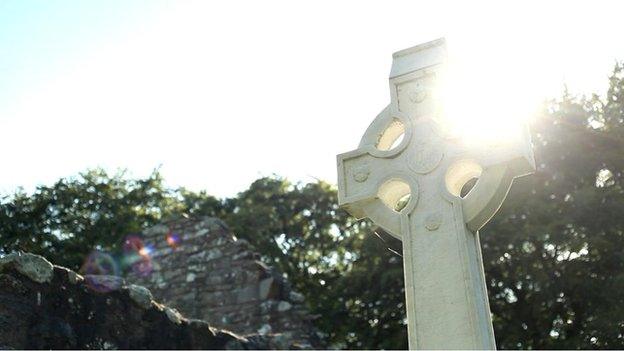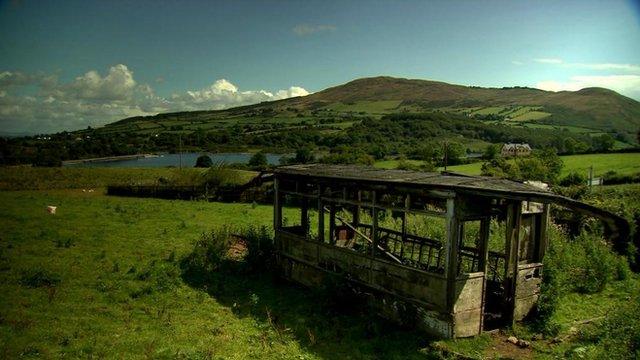Bandit country: Funding to preserve historical south Armagh land
- Published
The area had gained the nickname of "Bandit Country", as Chris Buckler reports
Almost a million pounds of lottery money is being given to preserve and protect a part of south Armagh that was once known as 'bandit country'.
The title was given during the Troubles in Northern Ireland to an area which had the reputation of being an IRA stronghold.
That made it a place to watch for the security forces.
On many hills, the British army built watchtowers that once dominated the landscape, and working as a soldier in this spectacular scenery was a dangerous job for many years.
Andrew Rawding is a Church of Ireland minister, but in the early 1990s he was a soldier posted in south Armagh.
He joined me to climb a hill where one of the army bases once stood.

Working as a soldier in south Armagh was a dangerous job for many years, in sharp contrast with the beautiful scenery of the countryside
From the top you can see the main Belfast to Dublin railway line, where his friend and colleague was murdered in an IRA bombing.
"We are in a stunning area, a really stunning part of the world - and yet some terrible things have taken place here, done by all sides," he said.
"It was 1 May 1992 that Andrew Grundy was killed and it's only in the last couple of months I have been to his grave.
"(Being) back here, I have a slight pain under my diaphragm.
"I am reminded of the impact of what went on here on myself, the soldiers who were under my command and on their families."
'Untouched natural beauty'
The images of that time contrast sharply with the calm and quiet of this countryside.
It is almost a decade since the military installations were demolished and now there is an attempt to open up this land to everyone.
The Heritage Lottery Fund has awarded a total of £980,000 for a variety of conservation projects around the Ring of Gullion.
Some of the money will be used to create trails that will allow people to walk in areas that were never accessible before.
In a number of cases, it is only a matter of years since mines and barbed wire deliberately kept the public away for security reasons.
Des Murphy of the Ring of Gullion landscape partnership scheme, said the land was "untouched natural beauty".

Some of the lottery funding will be used to create trails that will allow people to walk in areas that were never accessible before
He said: "To tag it with bandit country just sours the whole taste of trying to get tourists here.
"This is where the roots of Ireland began - in the Ring of Gullion area."
Myths and legends
Certainly, it is an area with links to centuries of mythology, long before it became associated with notoriety.
There are hundreds of stories that have been shared down countless generations of families in this part of Armagh.
Darren Rice, who worked on the bid for lottery funding, said: "We have links to (the legendary giant) Finn McCool on this mountain, and King Conor of Ulster has connections to this area.
"The place is just bursting with myths and legends."
Fact and folklore often meld together in the stories told here, but the historic nature of sites across this county is undeniable.
Ruins of churches, castles and tombs can all be found around the famous Slieve Gullion mountain.
In the graveyard at Killevy Old Churches, I met Marie Moonen who was visiting the island of Ireland with her husband John.
"We're from Vancouver in Canada which is only around 100 years old," she said.
Personal history
Others come searching, not to find the past of this island, but for the roots of their families.
Cash from the lottery funding will also be used to train people so they can pass on details of the historical and archaeological significance of these places.

The Slieve Gullion mountain in south Armagh is immersed in mythology and attracts tourists from all over the world
Mr Rice said: "They are blown away when you tell them the dates.
"What the foreign tourists love is the names on all the graves. It's all about genealogy and tracing their roots back here."
New maps are being produced to mark out walks and spots of specific interest, like Moyry Castle and megalithic tombs.
Slieve Gullion was immortalised in story and song as Northern Ireland's mountain of mystery.
After years of staying away, people are now being encouraged to seek out its secrets.
- Published23 August 2014
